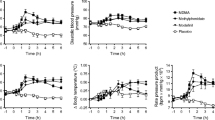Summary
Fourteen, healthy students volunteered for a double-blind, cross-over trial of temazepam 20 mg (soft gelatine capsule), nitrazepam 10 mg (uncoated tablet) and placebo in matched formulations, single doses of each being given for 10 nights with a three-week wash-out period between each treatment. Residual drug effects were measured objectively (psychomotor skills) and subjectively (visual analogue scales) in the morning and afternoon of Days 0 (before the first tablet), 1 and 10. The subjects also recorded various events during each treatment period. Serum benzodiazepine concentrations were bioassayed in blood samples taken after the last assessment. Both benzodiazepines shortened sleep latency during the first few nights, and nitrazepam prolonged the duration of sleep. The residual effect of drowsiness was noted during the nitrazepam period, whilst temazepam proved less sedating. The ‘morning after‘ effect was a subjective observation and not an objective measurement. The learning effect interfered with the complex objective assessments, and simple measurement of exophoria with the Maddox wing test provided the clearest objective evidence of drug effects. On Day 10 residual concentrations of nitrazepam were detectable in the serum whereas the level of temazepam was found to be low or negligible. It is concluded, that temazepam 20 mg in a soft gelatine capsule is a suitable hypnotic for subjects whose daily work requires constant alertness.
Similar content being viewed by others
References
Aaltonen L, Scheinin M (1982) Application of radioreceptor assay of benzodiazepines for toxicology. Acta Pharmacol Toxicol 50: 206–212
Aranko K, Mattila MJ, Seppälä T (1983) Development of tolerance and cross-tolerance to the psychomotor actions of lorazepam and diazepam in man. Br J clin Pharmac 15: 545–552
Cook PJ, Huggett A, Graham-Pole R, Savage IT, James IM (1983) Hypnotic accumulation and hangover in elderly inpatients: a controlled double-blind study of temazepam and nitrazepam. Br Med J 286: 100–102
Fuccella LM, Bolcioni G, Tamassia V, Ferrario L, Tognoni G (1977) Human pharmacokinetics and bioavailability of temazepam administered in soft gelatin capsules. Eur J Clin Pharmacol 12: 383–386
Greenblatt DJ, Shader RI, Divoll M, Harmatz JS (1981) Benzodiazepines: a summary of pharmacokinetic properties. Br J clin Pharmac 11: 11S-16S
Greenblatt DJ, Divoll M, Abernethy DR, Ochs HR, Shader RI (1983) Clinical pharmacokinetics of the newer benzodiazepines. Clin Pharmacokinet 8: 233–252
Hindmarch I (1975) A 1,4-benzodiazepine, temazepam (K 3917), its effect on some psychological parameters of sleep and behaviour. Arzneimittelforsch (Drug Res) 25: 1836–1839
Kangas L, Breimer DC (1981) Clinical pharmacokinetics of nitrazepam. Clin Pharmacokinet 6: 346–366
Karim AKMB, Evans DAP (1976) Polymorphic acetylation of nitrazepam. J Med Genet 13: 17–19
Lahtinen U, Lahtinen A, Pekkola P (1978) The effect of nitrazepam on manual skill, grip strength, and reaction time with special reference to subjective evaluation of effects on sleep. Acta Pharmacol Toxicol 42: 130–134
Lienert GA, Kohnen R, Keuchel I (1982) Schlafmittelwirkungen bei alten und jungen Versuchspersonen: Die Wirkungs-bedarfshypothese. Z Gerontol 15: 50–52
Liljequist R, Mattila MJ (1979) Acute effects of temazepam and nitrazepam on psychomotor skills and memory. Acta Pharmacol Toxicol 44: 364–369
Mattila MJ, Alhava E, Tiitinen H (1969) Acetylation pattern of different sulfonamides in rapid and slow isoniazid inactivators. Ann Med Exp Biol Fenn 47: 124–128
Mattila MJ, Palva E, Savolainen K (1982) Caffeine antagonizes diazepam effects in man. Med Biol 60: 121–123
Nicholson AN (1981) The use of short- and long-acting hypnotics in clinical medicine. Br J clin Pharmac 11: 61S-69S
Skolnick P, Goodwin FK, Paul SM (1979) A rapid and sensitive radioreceptor assay for benzodiazepines in plasma. Arch Gen Psychiat 36: 78–80
Author information
Authors and Affiliations
Rights and permissions
About this article
Cite this article
Mattila, M.J., Aranko, K., Mattila, M.E. et al. Objective and subjective assessment of hangover during subacute administration of temazepam and nitrazepam to healthy subjects. Eur J Clin Pharmacol 26, 375–380 (1984). https://doi.org/10.1007/BF00548770
Received:
Accepted:
Issue Date:
DOI: https://doi.org/10.1007/BF00548770




